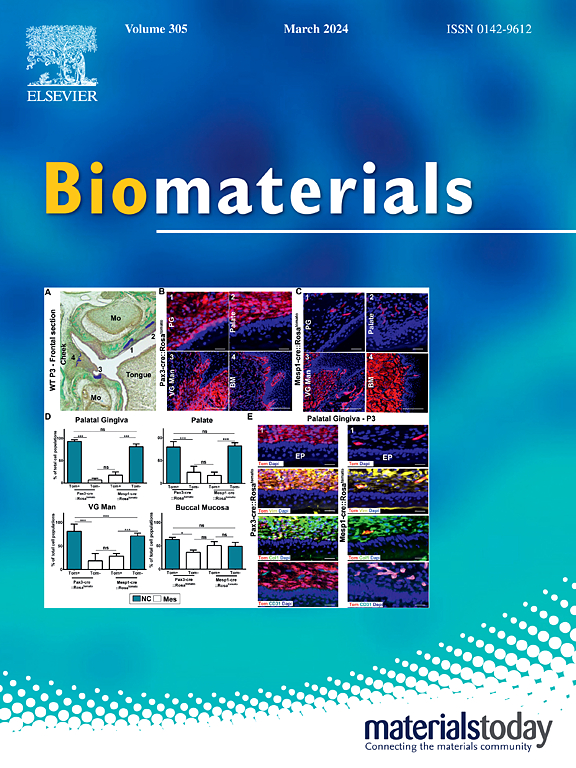巨噬细胞膜包被近红外光可降解氮化碳基因载体用于肝纤维化气体基因治疗
IF 12.9
1区 医学
Q1 ENGINEERING, BIOMEDICAL
引用次数: 0
摘要
肝纤维化影响着全球数百万患有各种肝脏疾病的患者。因此,迫切需要开发新的治疗策略。由于巨噬细胞募集在肝纤维化过程中增加,巨噬细胞膜包被仿生复合物可以设计用于靶向抗肝纤维化治疗。本研究提出了一种仿生“气体基因”策略来增强抗肝纤维化的疗效。开发了一种巨噬细胞膜包被氮化碳的仿生DNA纳米颗粒递送平台(M-PEISeCCNs@DNA)。巨噬细胞膜包被促进M-PEISeCCNs@SBP1转运到肝纤维化部位,逆转载体的正电荷,避免阳离子诱导的细胞毒性。在近红外(NIR)照射下,M-PEISeCCNs@SBP1可触发水裂解产生O2,从而缓解缺氧,减轻肝纤维化。SBP1-DNA质粒的光响应释放也是通过载体光解实现的。传递的SBP1- dna和载体中的硒元素协同上调硒结合蛋白1 (selenium binding protein-1, SBP1)的表达。此外,我们首次证明SBP1是肝纤维化的有效治疗靶点,其过表达抑制上皮-间质转化(EMT)并减轻小鼠ccl4诱导的肝纤维化。在本实验中,M-PEISeCCNs@SBP1通过sbp1介导的NOTCH2/Wnt途径有效治疗小鼠肝纤维化。本文章由计算机程序翻译,如有差异,请以英文原文为准。

Macrophage membrane-coated NIR light-photodegradable carbon nitride-based gene vectors for gas-gene therapy of liver fibrosis
Hepatic fibrosis impacts millions of patients globally suffering from various liver diseases. Therefore, development of novel therapeutic strategies is urgently required. Since macrophage recruitment increases during liver fibrosis progression, macrophage membrane-coated biomimetic complexes can be designed for targeted anti-liver fibrosis therapy. In this study, a biomimetic “gas-gene” strategy was proposed to enhance anti-liver fibrosis efficacy. A macrophage membrane-coated carbon nitride-based biomimetic delivery platform loaded with DNA nanoparticles (M-PEISeCCNs@DNA) was developed. The macrophage membrane coating facilitated the delivery of M-PEISeCCNs@SBP1 to the liver fibrosis site and reversed the positive charge of the carriers to avoid cation-induced cytotoxicity. Under near-infrared (NIR) irradiation, M-PEISeCCNs@SBP1 could trigger water splitting to produce O2, thereby mitigating hypoxia and alleviating liver fibrosis. The light-responsive release of the SBP1-DNA plasmid was also achieved through carrier photolysis. The delivered SBP1-DNA and the Se element within the vectors synergistically upregulated the expression of selenium-binding protein-1 (SBP1). Additionally, we demonstrated for the first time that SBP1 is an effective therapeutic target for liver fibrosis, and its overexpression inhibits epithelial-mesenchymal transition (EMT) and attenuates CCl4-induced liver fibrosis in mice. In this experiment, M-PEISeCCNs@SBP1 effectively treated liver fibrosis in mice through the SBP1-mediated NOTCH2/Wnt pathway.
求助全文
通过发布文献求助,成功后即可免费获取论文全文。
去求助
来源期刊

Biomaterials
工程技术-材料科学:生物材料
CiteScore
26.00
自引率
2.90%
发文量
565
审稿时长
46 days
期刊介绍:
Biomaterials is an international journal covering the science and clinical application of biomaterials. A biomaterial is now defined as a substance that has been engineered to take a form which, alone or as part of a complex system, is used to direct, by control of interactions with components of living systems, the course of any therapeutic or diagnostic procedure. It is the aim of the journal to provide a peer-reviewed forum for the publication of original papers and authoritative review and opinion papers dealing with the most important issues facing the use of biomaterials in clinical practice. The scope of the journal covers the wide range of physical, biological and chemical sciences that underpin the design of biomaterials and the clinical disciplines in which they are used. These sciences include polymer synthesis and characterization, drug and gene vector design, the biology of the host response, immunology and toxicology and self assembly at the nanoscale. Clinical applications include the therapies of medical technology and regenerative medicine in all clinical disciplines, and diagnostic systems that reply on innovative contrast and sensing agents. The journal is relevant to areas such as cancer diagnosis and therapy, implantable devices, drug delivery systems, gene vectors, bionanotechnology and tissue engineering.
 求助内容:
求助内容: 应助结果提醒方式:
应助结果提醒方式:


